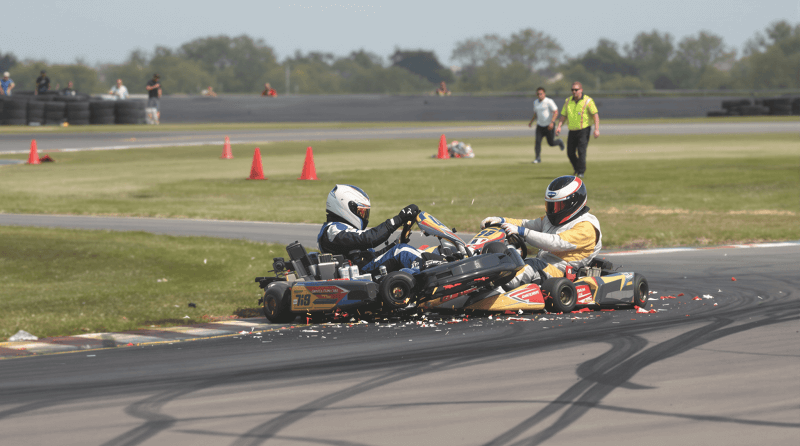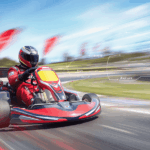Go-karting delivers an adrenaline rush like few other activities, but with high speeds come real risks. Whether you’re a weekend racer or a parent of a young driver, understanding what causes go-kart accidents and how to prevent them is crucial for enjoying this thrilling sport safely.
Common Causes of Go-Kart Accidents
I’ve been around kart tracks for years, and I’ve seen firsthand how quickly things can go wrong. Let’s break down the main culprits behind most go-kart accidents.
Excessive Speed
Speed is what makes karting exciting, but it’s also the number one factor in accidents. When you’re flying around a track at 45+ mph, your reaction time shrinks dramatically. Even a split-second delay can mean the difference between a clean lap and a collision.
The physics are simple: higher speeds mean less time to correct mistakes. Most recreational karts can reach 40-50 mph, while racing karts can exceed 80 mph on straightaways!
Track Design and Conditions
Narrow tracks with tight corners create bottlenecks where karts bunch together. These congested areas become accident hotspots, especially during competitive races where everyone’s fighting for position.
Track surface conditions matter too. A patch of oil, debris, or water can send even experienced drivers into a spin. Indoor tracks tend to have more consistent conditions, while outdoor venues introduce variables like temperature changes that affect grip.
Driver Inexperience
Nothing replaces seat time when it comes to karting safety. Inexperienced drivers often misjudge braking points, take improper racing lines, or make unpredictable moves that catch others off guard.
Statistics show that nearly 70% of kart accidents involve at least one driver with less than six months of experience. This is why most reputable tracks offer training sessions and enforce progression through speed classes.
How Go-Karts Flip Over
The most dangerous type of go-kart accident is a flip. Understanding the mechanics behind these incidents can help you avoid them entirely.
The “Launching Ramp” Effect
When your kart’s front end rides up over another kart’s bumper or tire, it creates a launching ramp effect. This typically happens during rear-end collisions or when a kart spins out in front of you.
The front of most karts sits just 1-2 inches off the ground, making it easy for one kart to climb over another. Once your front wheels leave the ground, you lose steering control completely.
The Dreaded “Tire-to-Tire” Contact
Tire-to-tire contact is what keeps race directors up at night. When the rotating tire of your kart touches the rotating tire of another kart, the opposing forces create a catapult effect.
This phenomenon, sometimes called the “kiss of death” in karting circles, can launch a kart several feet into the air at racing speeds. The faster you’re going, the higher and farther you’ll fly – potentially resulting in a complete flip.
Essential Prevention Strategies
After coaching dozens of new racers, I’ve developed some foolproof strategies to minimize accident risks. These aren’t just suggestions – they’re essential practices for anyone serious about karting safety.
Proper Following Technique
When following another kart, position yourself directly behind their tail, not offset to either side. This “shadow position” ensures that if they brake suddenly, you’ll make bumper-to-bumper contact rather than the more dangerous tire-to-tire or side impact.
Maintain at least a two-kart gap when possible, especially in high-speed sections. This buffer gives you precious reaction time if something goes wrong ahead.
Smart Overtaking Decisions
The safest pass is one that’s completed before the braking zone. Attempting passes in corners leads to most racing accidents. Wait for straightaways where you have room to maneuver cleanly alongside the other kart.
Never attempt to “dive-bomb” into a corner unless you’re at least halfway alongside the other kart before turn-in. Patience pays off – an unsuccessful pass attempt often costs more time than waiting for a better opportunity.
Track Familiarity
Before pushing the limits, take several reconnaissance laps to learn the track layout. Pay special attention to braking markers, corner apex points, and track width variations.
Most tracks offer practice sessions specifically for this purpose. Use them! Understanding where you can safely push and where you need to exercise caution prevents the surprise factor that leads to many accidents.
Essential Safety Equipment
I learned the hard way that proper safety gear isn’t optional – it’s your last line of defense when prevention fails. Here’s what you absolutely need:
Helmet Requirements
A full-face helmet with proper certification (Snell K2015/K2020 or equivalent) is non-negotiable. Your helmet should fit snugly without pressure points, and the chin strap must be secure enough that you can’t pull the helmet off when fastened.
Replace your helmet immediately after any significant impact, even if there’s no visible damage. The protective foam compresses during impacts and won’t provide the same protection twice. Check out additional safety equipment recommendations for youth drivers.
Protective Clothing
Wear a neck brace to reduce whiplash risk, especially for younger drivers. Pair this with a rib protector vest, as rib injuries are among the most common in karting due to lateral G-forces.
Gloves designed specifically for karting provide both grip and abrasion protection. Racing suits made from abrasion-resistant materials like Cordura or leather offer crucial protection during slides.
Weather Considerations
Weather conditions significantly impact track safety and require specific driving adjustments.
Wet Weather Driving
Rain transforms the racing experience completely. Go-karting in wet weather requires a different approach to braking, acceleration, and cornering. Wet tracks reduce grip by up to 50%, demanding smoother inputs and earlier braking.
In wet conditions, the racing line often shifts away from the traditional dry line. The rubber buildup that provides grip in dry conditions becomes slippery when wet, so experienced drivers seek out unused portions of the track for better traction.
Emergency Response Protocol
Despite all precautions, accidents happen. Knowing exactly what to do in those critical moments can prevent a bad situation from becoming worse.
Immediate Post-Accident Steps
First, take a breath and assess your condition. Can you move all extremities? Are you experiencing sharp pain anywhere? Don’t rush to move if you suspect a serious injury.
If you’re able, check on others involved in the accident. Clear communication helps track marshals understand the severity of the situation and respond appropriately.
Safe Extraction Procedure
Stay in your kart until track officials signal it’s safe to exit, unless there’s immediate danger (fire, fuel leak, etc.). When exiting, be aware of other karts that may still be circulating on track.
Move to a safe location behind barriers when possible. If your kart is still operational, drive it slowly off the racing line to a safe area rather than abandoning it in a dangerous position.
Training and Skill Development
The single best way to prevent accidents is to become a better, more skilled driver. Investing in proper training pays dividends in safety.
Professional Instruction
Consider taking a karting school course taught by experienced racers. These structured programs teach proper techniques and safety protocols in a controlled environment.
Many tracks offer one-on-one coaching sessions where instructors can identify and correct dangerous habits before they lead to accidents. Understanding racing flags and signals is also essential for safe track operation.
Progressive Skill Building
Master fundamentals at lower speeds before advancing to faster karts. This gradual progression builds muscle memory and instinctive reactions that serve you well in emergency situations.
Practice specific scenarios like wet weather driving and close-quarters racing in controlled settings before encountering them in competitive situations. Learning how to maximize tire grip safely is another crucial skill.
Mechanical Safety Checks
Mechanical failures can lead to serious accidents. Regular safety checks are essential before every session.
Pre-Race Inspection
Before hitting the track, always check your kart’s critical components. Inspect brake function, steering response, and tire pressure at minimum.
Pay special attention to fasteners that might vibrate loose during racing. A single loose bolt on your steering components or brake system can lead to catastrophic failure at speed.
Conclusion
I’ve had my share of close calls on the track, and each one taught me something valuable about safety. Go-karting is inherently risky, but with proper knowledge, equipment, and technique, those risks become manageable.
Remember that no position, lap time, or trophy is worth risking serious injury. The best racers aren’t just fast – they’re consistently safe, making smart decisions that keep them in the race week after week, year after year. For more comprehensive guidance, check out our complete go-kart safety guide.
Take these lessons to heart, implement them every time you hit the track, and you’ll enjoy all the thrills of karting while minimizing the spills. Stay safe out there!

Goran, an experienced go-kart racer, fuels GoKartLife.com with his passion and expertise. He offers valuable insights and tips for fellow enthusiasts, fostering the growth of the go-kart community. Join Goran at GoKartLife.com and immerse yourself in this exhilarating sport.
Last modified: April 18, 2025



